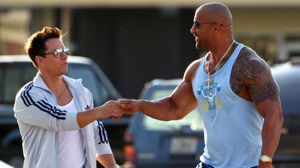There's no such thing as small in a Michael Bay film. And I have a feeling that this truth is relevant even to the less glamorous jobs on set. Though I suspect that set dressing occupies a place of importance when Bay is in the director's chair; his films are primarily interested in trying to show the world in the coolest, sexiest, most epic way possible. In a sense, everything in a Michael Bay film is set dressing: cars, helicopters, Megan Fox.
Pain & Gain is shot with the same low-angle, high-saturation awe with which Bay seeks to give every character a god-like glow. It still loses its focus in scenes that fetishize luxury (placing more importance on your set dressings than the story), and it's still guided by the same homophobic, misogynistic, bro-centric vision that made films like Bad Boys, Armageddon, and The Rock so risible.
However, because Pain & Gain is the story of incompetent kidnapping and accidental murder set in Miami's bodybuilding subculture, Bay has found the perfect place to indulge in these aesthetics. It's a place where his particular brand of objectification makes complete sense. Sure, as in his previous films these characters are treated and photographed as objects of desire; but the thing is, these characters would love that.
Mark Wahlberg, playing personal trainer Daniel Lugo, often speaks of the American Dream he thinks he's owed, even quoting a tenet of the I-deserve-it-all ethos of The Secret: _If you deserve it, the universe will serve it." He's talking, really, about all the ostentation with which you populate Bay's sets. In Lugo's all-or-nothing view, everything and everyone who impedes his march is disposable, objects to be tossed aside in pursuit of his dream. He wants the oceanside house, the _Miami Vice-style cigar boat, the Porsche and the Lamborghini. He wants to live in a Michael Bay film.
Could Michael Bay possess this much self-awareness? Did you detect a master plan when dressing sets that are almost a parody of the American consumer ideal? More importantly, does it matter? Even if this self-criticism is unintentional, it's there on the screen. The three main characters are physical embodiments of Bay's bigger-is-better approach to…well, everything. This physicality also reflects the high costs of such a lifestyle: the mutation of self-image; literal impotence. That this all comes through in sly, affecting performances by Wahlberg, Anthony Mackie, and especially Dwayne "The Rock" Johnson, just added to my disorientation.
Not that everything works on this meta level. Pain & Gain is still overstuffed. It runs a bloated 130 minutes, padded out by overindulgent slow motion, freeze frames, and other Bayian (I'm trademarking that adjective) flourishes. But maybe that's the point. Maybe the filmmaking is a criticism of itself. In Pain & Gain's world, you either go all in or you go home. And the film itself - the style, the length, the overindulgence, and, yes, even the set dressing - follow suit in order to maintain some sense of thematic integrity.
And, at this point in his career, a little honesty from Michael bay feels like progress.
Dreaming of the simple life,
Casey







